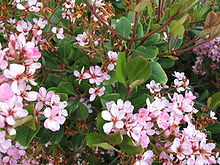Rhaphiolepis (/ˌræfiˈɒlɪpɪs/ RAF-ee-OL-ip-iss or /ˌræfioʊˈlɛpɪs/ RAF-ee-oh-LEP-iss)[2] is a genus of about fifteen species of evergreen shrubs and small trees in the family Rosaceae, native to warm temperate and subtropical East Asia and Southeast Asia, from southern Japan, southern Korea and southern China, south to Thailand and Vietnam. In searching literature it is well to remember that the name commonly is misspelt "Raphiolepsis". The genus is closely related to Eriobotrya (loquats), so closely in fact, that members of the two genera have hybridised with each other; for example the "Coppertone loquat" is a hybrid of Eriobotrya deflexa X Rhaphiolepis indica. The common name hawthorn, originally specifically applied to the related genus Crataegus, now also appears in the common names for some Rhaphiolepis species. For example, Rhaphiolepis indica often is called "Indian hawthorn", and Rhaphiolepis umbellata, "Yeddo hawthorn".
| Rhaphiolepis | |
|---|---|
 | |
| Rhaphiolepis indica in flower | |
| Scientific classification | |
| Kingdom: | Plantae |
| Clade: | Tracheophytes |
| Clade: | Angiosperms |
| Clade: | Eudicots |
| Clade: | Rosids |
| Order: | Rosales |
| Family: | Rosaceae |
| Subfamily: | Amygdaloideae |
| Tribe: | Maleae |
| Subtribe: | Malinae |
| Genus: | Rhaphiolepis Lindl. |
| Species | |
see text | |
| Synonyms[1] | |
| |
Description

The species vary in size, some only reaching 1–1.5 m (3 ft 3 in – 4 ft 11 in), while R. ferruginea can reach 10 m (33 ft). The leaves are alternate, leathery, glossy dark green, simple, 3–9 cm (1–3+1⁄2 in) long, with an entire or serrated margin. The flowers are white or pink, 1–2 cm (1⁄2–3⁄4 in) diameter, produced in small to large corymbs with panicle structure. The fruit is a small pome 1–2 cm (1⁄2–3⁄4 in) diameter, ripening dark purple to black, usually containing only a single seed.
Taxonomy
Rhaphiolepis is closely related to loquats and toyon and is in the apple subtribe along with many other commercially important fruit like pears. Recent phylogenetic research has suggested Rhaphiolepis and Eriobotrya (loquats) be merged.[3] Plants of the World Online treats Eriobotrya as a synonym of Rhaphiolepis.[4]
Research suggests the following phylogenetic relationships:[5]
| 7 species | |||||||||||||||||||
| |||||||||||||||||||
| 117 |
Cultivation and uses
The best known species is Rhaphiolepis indica (Indian hawthorn) from southern China, grown for its decorative pink flowers, and popular in bonsai culture. Rhaphiolepis umbellata (Yeddo hawthorn) from Japan and Korea has blunter leaves and white flowers. It is the hardiest species, tolerating temperatures down to about −15 °C (5 °F).[citation needed]
The fruit of some varieties is edible when cooked, and can be used to make jam, but some ornamental varieties bear fruit that is of no culinary value.[citation needed]
Indian Hawthorn is a mainstay horticultural specimen in southern United States. It is often found in commercial as well as in private landscapes. Often it is trimmed into small compact hedges or balls for foundation plants. It has been successfully pruned into a standard form as well as small dwarf-like trees up to 4.5 m (15 ft) in height.
The use of Rhaphiolepis in landscapes in humid regions is limited by the susceptibility of many of its species and hybrids to a disfiguring leaf spot disease caused by fungi in the genus Entomosporium.
Species
45 species are currently recognized, according to Plants of the World Online. These include species formerly classed as Eriobotrya.[1]
- Rhaphiolepis angustissima (Hook.f.) B.B.Liu & J.Wen
- Rhaphiolepis balgooyi (K.M.Wong & Ent) B.B.Liu & J.Wen
- Rhaphiolepis bengalensis (Roxb.) B.B.Liu & J.Wen
- Rhaphiolepis bibas (Lour.) Galasso & Banfi – loquat
- Rhaphiolepis brevipetiolata J.E.Vidal
- Rhaphiolepis cavaleriei (H.Lév.) B.B.Liu & J.Wen
- Rhaphiolepis condaoensis (X.F.Gao, Idrees & T.V.Do) B.B.Liu & J.Wen
- Rhaphiolepis × daduheensis (H.Z.Zhang ex W.B.Liao, Q.Fan & M.Y.Ding) B.B.Liu & J.Wen
- Rhaphiolepis deflexa (Hemsl.) B.B.Liu & J.Wen – bronze loquat
- Rhaphiolepis dubia (Lindl.) B.B.Liu & J.Wen
- Rhaphiolepis elliptica (Lindl.) B.B.Liu & J.Wen
- Rhaphiolepis ferruginea F.P.Metcalf
- Rhaphiolepis fulvicoma (Chun ex W.B.Liao, F.F.Li & D.F.Cui) B.B.Liu & J.Wen
- Rhaphiolepis glabrescens (J.E.Vidal) B.B.Liu & J.Wen
- Rhaphiolepis henryi (Nakai) B.B.Liu & J.Wen
- Rhaphiolepis hookeriana (Decne.) B.B.Liu & J.Wen
- Rhaphiolepis indica (L.) Lindl. – Indian hawthorn
- Rhaphiolepis integerrima Hook. & Arn.
- Rhaphiolepis jiulongjiangensis P.C.Huang & K.M.Li
- Rhaphiolepis lanceolata Hu
- Rhaphiolepis laoshanica (W.B.Liao, Q.Fan & S.F.Chen) B.B.Liu & J.Wen
- Rhaphiolepis latifolia (Hook.f.) B.B.Liu & J.Wen
- Rhaphiolepis longifolia (Decne.) B.B.Liu & J.Wen
- Rhaphiolepis macrocarpa (Kurz) B.B.Liu & J.Wen
- Rhaphiolepis major Cardot
- Rhaphiolepis malipoensis (K.C.Kuan) B.B.Liu & J.Wen
- Rhaphiolepis merguiensis (J.E.Vidal) B.B.Liu & J.Wen
- Rhaphiolepis oblongifolia (Merr. & Rolfe) B.B.Liu & J.Wen
- Rhaphiolepis obovata (W.W.Sm.) B.B.Liu & J.Wen
- Rhaphiolepis petiolata (Hook.f.) B.B.Liu & J.Wen
- Rhaphiolepis philippinensis (S.Vidal) Kalkman
- Rhaphiolepis platyphylla (Merr.) B.B.Liu & J.Wen
- Rhaphiolepis poilanei (J.E.Vidal) B.B.Liu & J.Wen
- Rhaphiolepis prinoides (Rehder & E.H.Wilson) B.B.Liu & J.Wen
- Rhaphiolepis salicifolia Lindl.
- Rhaphiolepis salwinensis (Hand.-Mazz.) B.B.Liu & J.Wen
- Rhaphiolepis seguinii (H.Lév.) B.B.Liu & J.Wen
- Rhaphiolepis serrata (J.E.Vidal) B.B.Liu & J.Wen
- Rhaphiolepis stipularis (Craib) B.B.Liu & J.Wen
- Rhaphiolepis tengyuehensis (W.W.Sm.) B.B.Liu & J.Wen
- Rhaphiolepis umbellata (Thunb.) Makino – Yeddo hawthorn
- Rhaphiolepis williamtelliana (Champ. ex Benth.) B.B.Liu & J.Wen
- Rhaphiolepis wuzhishanensis W.B.Liao, R.H.Miau & Q.Fan
Gallery
- Thirty-year-old Indian hawthorn that has been pruned into a multi-trunked dwarf-like tree
- Indian hawthorn fruits
- Yeddo-Hawthorn tree at Brooklyn Botanic Garden in New York City


